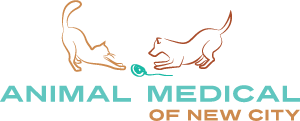Oral disease is one of the most common problems in veterinary medicine with nearly 100% of dogs and cats showing signs of periodontal disease by the age of three. Some problems that can result from oral disease include
- trouble chewing
- excessive salivation
- bad breath
Sometimes more severe problems can result from the inhalation of the bacteria living on your pet’s teeth leading to more serious systemic diseases (disease that extends throughout the body). While we encourage every owner to brush their pet’s teeth twice daily, sometimes the damage is too extensive and a professional dental cleaning is needed. However, on that note it is also imperative that our patients are brought in for routine dental cleanings even when there is no sign yet of gingivitis and periodontal disease (click here for a oral health schedule based on species and breed).
Especially for certain, predisposed breeds, a professional prophylaxis is the optimal way to prevent the onset of severe periodontal disease.
The Basics of Professional Pet Dentistry
At AMNC we provide our patients with a complete oral health assessment. A proper dental cleaning requires the use of ultrasonic power scalers to remove the plaque and tartar from your pet’s teeth. To ensure the safety of your pet, this procedure needs to be performed under general anesthesia. To get the process started, we recommend a complete physical examination and a pre-operative blood panel to check your pet’s overall health. On the day of the procedure your pet is monitored by one of our highly trained Licensed Veterinary Technicians before, during, and after the procedure. Once under light sedation, the doctors will be able to get a better look at what is really going on inside your pet’s mouth. AMNC’s dental cleanings and preventative therapies always include oral radiographs (x-rays) to see what is going on below the gum line as well as inside and around the tooth. Once the plaque and tartar is removed from the surface of your pet’s teeth, they will also be polished to help smooth the surface of the tooth and discourage plaque adherence. New therapeutic products proven to reduce plaque adherence and delay the onset of periodontal disease are now being used routinely at AMNC. Be sure to discuss these important new advancements with us!
Prevention is Best
The most effective treatment for oral disease is prevention. It is important to get your dog or cat used to having their teeth brushed at a young age. Here’s a link to a series of short, lively videos on pet dentistry by Vicki Byard, one of our nation’s leading veterinary dental technicians.
